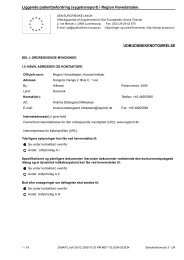Territorial Review Copenhagen - Region Hovedstaden
Territorial Review Copenhagen - Region Hovedstaden
Territorial Review Copenhagen - Region Hovedstaden
Create successful ePaper yourself
Turn your PDF publications into a flip-book with our unique Google optimized e-Paper software.
158<br />
In designing a detailed scheme of congestion charge such as the area and time<br />
covered, vehicle type charged, price level and structure (flat, gradual or<br />
variable), discount and exemption, policy makers should analyse the following<br />
fundamental issues;<br />
<br />
<br />
<br />
<br />
<br />
<br />
<br />
<br />
Geographic structure of the city and the congestion analysis: Where<br />
is the congestion severe? Area (polygon) or main avenues (line)?<br />
Are there any physical alternatives, such as road expansions? What is<br />
the residential density in the area? Who contributes to the congestion<br />
in the city? Do most residents or commuters live outside the city?<br />
Impact on economic efficiency: How much will the congestion<br />
charge improve traffic conditions in terms of time and money? What<br />
are the impacts on business?<br />
Financial sustainability: Will the revenue raised afford the initial<br />
costs and operating expense?<br />
Distributional effect: Given that exemptions and discounts usually<br />
accompany such plans, the distributional effect is usually complex.<br />
Who will benefit and lose from the introduction of the plan? Are the<br />
impacts progressive, regressive or neutral?<br />
Impact on general national and local finance: Impact on fuel tax,<br />
parking revenue if managed locally, cost of parking enforcement, etc.<br />
Which sector of national and local governments increase or decrease<br />
the fiscal balance?<br />
The possibility of improving alternative modes of transport in<br />
advance of the introduction of the congestion charge: How and how<br />
much can it mitigate the impact of the congestion charge?<br />
Possible impact on the surrounding area: How much and where will<br />
the through-traffic go? How much additional parking should be<br />
supplied close to the boundary? What are land use impacts?<br />
Impact on environment: Given that climate change is an increasing<br />
concern, governments are highly likely to add the environmental<br />
consideration in the congestion charge scheme. Will the congestion<br />
charge contribute to the decrease of CO 2 emissions or worsen them<br />
by increasing through-traffic?<br />
London: The GLA originally introduced the London Congestion charge<br />
covering the parts of Central London in February 2003, and extended the area<br />
into part of West London in February 2007. The extension increased the resident<br />
coverage from 150 000 to about 230 000. The main objectives of the charge are<br />
to reduce congestion, and to raise funds for investment in London‘s<br />
transportation system. The charge was originally GBP 5 a day, but was later<br />
increased to GBP 8 a day. An entity called Transport for London (TfL) manages<br />
the charging system. The TfL estimated that the level of traffic of all vehicle

















